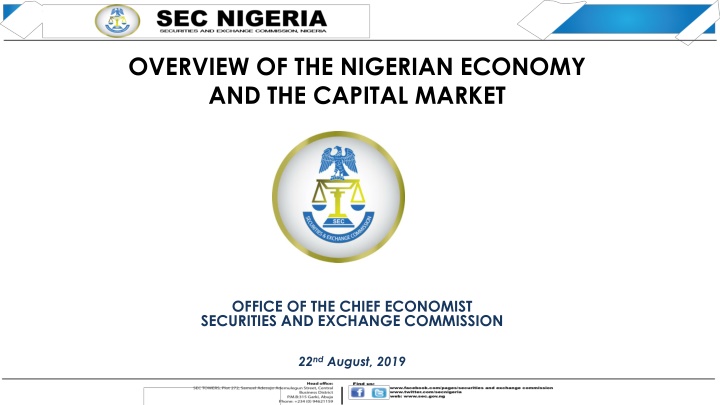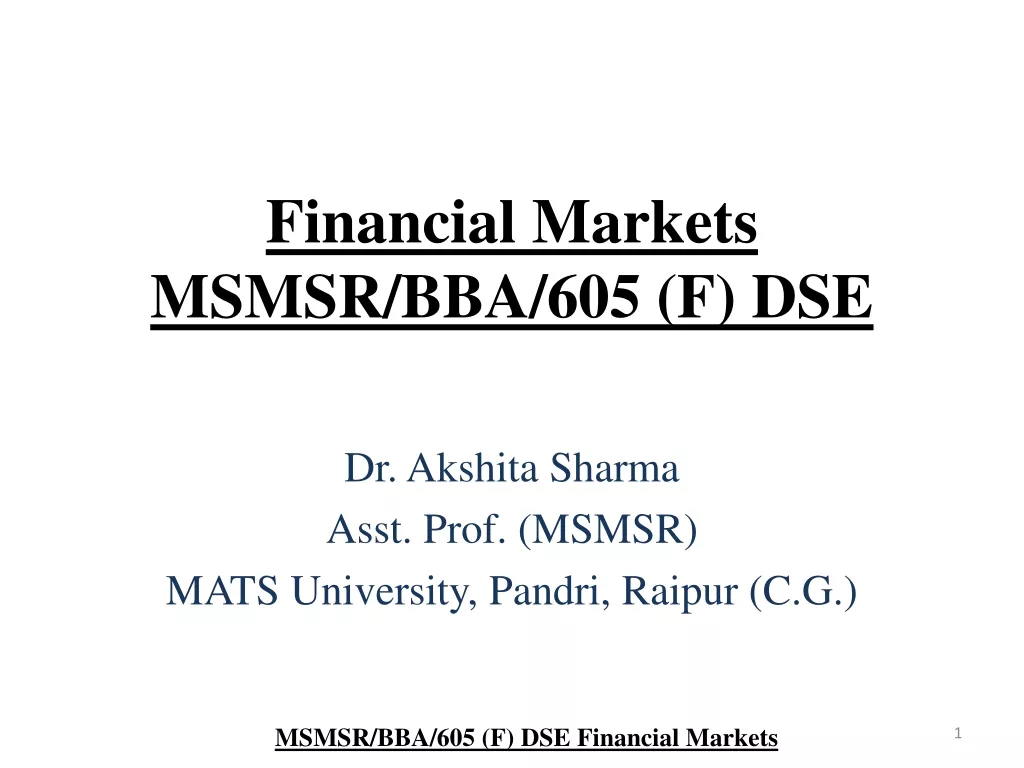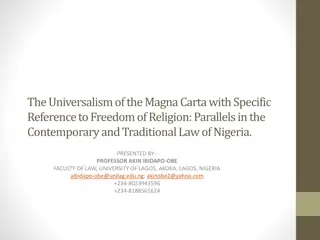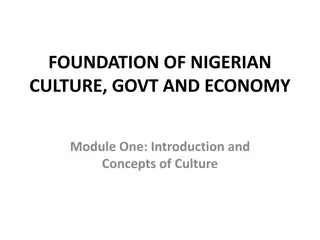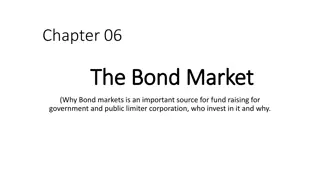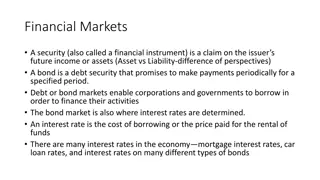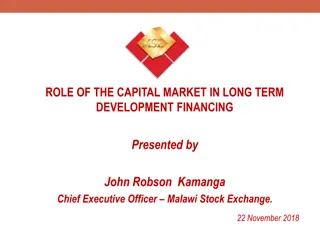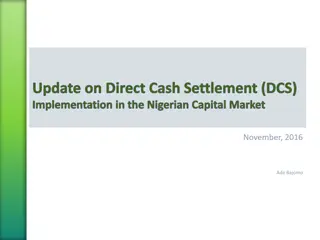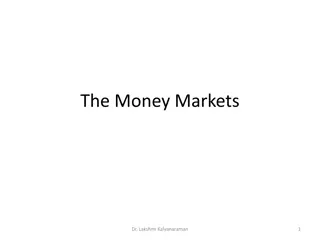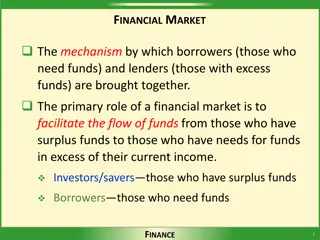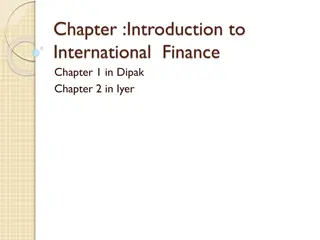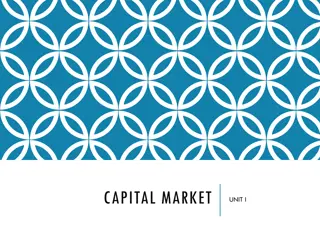Overview of Nigerian Economy and Capital Markets
The Nigerian economy overview including global and domestic factors, market activities, outlook, and growth projections. Insights into the global economy, domestic output, prices, external sector, and more. Analysis of key sectors such as agriculture, industries, and services. Discussion on inflation, exchange rates, and foreign reserves.
Download Presentation

Please find below an Image/Link to download the presentation.
The content on the website is provided AS IS for your information and personal use only. It may not be sold, licensed, or shared on other websites without obtaining consent from the author.If you encounter any issues during the download, it is possible that the publisher has removed the file from their server.
You are allowed to download the files provided on this website for personal or commercial use, subject to the condition that they are used lawfully. All files are the property of their respective owners.
The content on the website is provided AS IS for your information and personal use only. It may not be sold, licensed, or shared on other websites without obtaining consent from the author.
E N D
Presentation Transcript
OVERVIEW OF THE NIGERIAN ECONOMY AND THE CAPITAL MARKET OFFICE OF THE CHIEF ECONOMIST SECURITIES AND EXCHANGE COMMISSION 22nd August, 2019
Table of Contents The Global Economy Domestic Output and Prices Prices and Employment External Sector Activities Oil and Commodities Market Market for New Issues (Primary Market) Secondary Markets Outlook Companies and SDGs
The Global Economy (IMF, WEO-JUL) Global growth in the first half of the year was subdued due to Brexit uncertainties Trade tensions Geopolitical tensions Volatile oil prices The International Monetary Fund (IMF) revised global growth projection down by 0.1% The US Fed and the European Central Bank looking towards policy easing Low inflation Slow down in growth UK Brexit-related uncertainties No-deal Brexit? China economy expected to slow Trade tensions with the US Regulatory tightening Nigeria growth revised up from 2.0% to 2.3% Rising oil price, but Recent fall in oil prices and OPEC production quota may impact growth Country/Region World Advanced Eco. Euro Area EMs & Developing Sub-Sah. Africa kk United States United Kingdom .. China India Brazil South Africa 2017 3.8 2.4 2.4 4.8 2.9 2018 3.6 2.2 1.9 4.5 3.1 2019 3.2 1.9 1.3 4.1 3.4 2020 3.5 1.7 1.6 4.7 3.6 2.2 1.8 2.9 1.4 2.6 1.3 1.9 1.4 6.8 7.2 1.1 1.4 6.6 6.8 1.1 0.8 6.2 7.00 0.8 0.7 6.0 7.2 2.4 1.1 Nigeria 0.8 1.9 2.3 2.6
Output and Prices The Nigerian economy expanded by 2.01% in the Q1 19. Agriculture and services still the main drivers of growth GDP growth still below population growth The CBN and Managers Index (PMI) were 57.6 and 49.5 points respectively in Jul 19 FBN PMI indicates a contraction in the sector, while CBN PMI indicates an expansion Pointing to likely modest growth or slow down in Q2 19. Headline inflation slowed to 11.08% in Jul 19. Decline in food inflation due to favorable harvest Inflationary pressure expected to persist from: Minimum wage implementation Forex restriction on food items Sector Growth rate (%) Agriculture Industries Services Real Growth rate Non-oil Growth Q1-18 Q2-18 Q3-18 Q4-18 Total Q1-19 3.00 6.58 -0.47 1.89 0.76 1.19 0.4 2.12 1.50 2.05 1.91 -0.11 2.64 1.81 2.32 2.46 0.95 2.9 2.38 2.7 2.12 1.87 1.83 1.91 2.00 3.17 0.04 2.41 2.01 2.47 FBN Purchasing Headline Inflation (%) 15.13 14.33 13.34 12.48 11.61 11.44 11.40 11.37 11.37 11.31 11.28 11.28 11.26 11.25 11.23 11.23 11.22 11.14
External Sector External Reserves ($bn) Exchange rate stable over the last couple of years CBN spot and parallel differential stable. Stable rates good for the real and financial sectors As long as it is not artificial Foreign exchange intervention expected for the foreseeable future 47.8 47.6 47.5 47.1 46.3 45.8 45.1 45.1 44.8 44.4 44.3 43.2 43.1 42.5 42.3 42.2 42.0 40.7 36.9 34.3 33.8 32.5 31.8 30.8 30.7 30.3 30.3 30.2 29.6 27.9 Official Parallel Jul-17 Jul-18 Jun-17 Jun-18 Jun-19 Apr-17 May-17 Apr-18 May-18 Apr-19 May-19 Mar-17 Dec-17 Mar-18 Dec-18 Mar-19 Feb-17 Aug-17 Sep-17 Nov-17 Feb-18 Aug-18 Sep-18 Nov-18 Feb-19 Jan-17 Jan-18 Jan-19 Oct-17 Oct-18 600.00 500.00 External reserves rose to $45.1bn in Jun 19, from $43.2bn in Jan 19. Now $44.2bn Movement mainly driven by oil price and foreign portfolio investors trade. Fall in oil prices a threat to reserve accretion Reducing buffers against external shocks Limit forex intervention But we can still cover over a year s import 400.00 300.00 200.00 100.00 - Jul-18 Mar-16 Jan-16 Apr-16 Nov-16 Jan-17 Apr-17 Nov-17 Jan-18 Apr-18 Nov-18 Jan-19 Apr-19 Feb-16 Sep-16 Feb-17 Mar-17 Sep-17 Feb-18 Mar-18 Sep-18 Feb-19 Mar-19 Jul-16 Aug-16 Jul-17 Aug-17 Aug-18 May-17 May-16 Dec-16 Dec-17 May-18 Dec-18 May-19 Jun-16 Oct-16 Jun-17 Oct-17 Jun-18 Oct-18 Jun-19
Oil Price and Production (OPEC) Crude oil production in June 2019 averaged 1.96mbpd From 1.65mbpd in January Highest in 4 years 2019 Budget estimate is 2.3mbpd Oil output decrease Implementation of output quota (1.68mbpd) 2.50 1.96 1.80 1.73 1.72 1.71 1.69 1.67 1.65 1.65 1.64 1.64 1.64 1.63 2.00 1.58 1.56 1.53 1.50 1.45 Production (mbp) 1.50 1.00 expected to 0.50 0.00 Crude US$65.59/b in Jun. 2019 Oil price currently at $56.73/b Weakening global demand Rising US production 2019 Budget estimate is $60pb OPEC output cut will likely moderate the fall in prices oil price averaged 90 80 82.09 Price (US$/b) 70 79.45 77.73 75.06 74.86 73.29 72.81 72.75 72.24 60 69.92 67.71 67.05 66.02 65.90 65.59 65.19 50 60.51 57.82 40 30 20
Primary Market Activities 1550.46 1308.30 Equities issued amounted to N5.6bn About 60% of issuances were right issues Others were bonus issues 918.94 615.39 New FGN bonds dominate the primary market From Jan-Jun 2019, FGN issued N615.4bn worth of bonds. 323.59 306.50 211.09 103.17 97.39 73.10 47.00 23.15 11.73 5.61 0.00 0.00 Corporate bond segment issued N73.1bn worth of bonds FGN issuance still dominating 2016 2017 2018 2019 (as @ June) Equities (N'B) FGN Bonds (N'B) Corporate Bonds (N'B) Sub-National Bonds (N'B)
Secondary Markets NSE 50.00 20.00 Market performance was bearish for most of year: Coming from a high base. Weak investor sentiment and sell-offs Weak corporate earnings Low economic growth The NSE All Share Index stood at 26,036.24 in Jan. 2017 and Equities Market Cap. at N8.98trn Rose to the high of 44,343.65 and N15.91trn in Jan. 2018 Declining trend commenced thereafter, closing Jun. 2019 at 29,966.87 and N13.22trn. Currently at 27,353 and N13.3trn respectively FMDQ Total turnover from Jan-Jun 2019 was N119.2trn 65% of 2018 total turnover (N182.86trn) Treasury bills dominate the market Accounted for 37.6% the total with a turnover of N44.8trn Followed by Foreign Exchange, which contributed 27.9% 40.00 15.00 30.00 10.00 20.00 Points (Thousands) Naira (Trillions) 5.00 10.00 0.00 0.00 Jan-17 Apr-17 Nov-17 Jan-18 Apr-18 Nov-18 Jan-19 Apr-19 Feb-17 Mar-17 Sep-17 Feb-18 Mar-18 Sep-18 Feb-19 Mar-19 Jul-17 Aug-17 Jul-18 Aug-18 May-17 Dec-17 May-18 Dec-18 May-19 Jun-17 Oct-17 Jun-18 Oct-18 Jun-19 Market Capitalization(N'trillion) All-Share Index NASD Total value in Jan-Jun 2019 was N7.29bn 23.7% of the total value traded in 2018. (N30.8bn) AFEX Total value of traded commodities Jan-Jun 2019 was N1.88bn 87.4% of the total value traded in 2018 (N2.15bn) White maize dominates trade Followed by ginger and paddy rice. Palm Kernel valued at N1.92mn was traded for the first time in May 2019.
Outlook Economy Global growth expected to slow down in 2019. Oil prices have slumped over rising US production and global demand. The US- China trade war will likely weigh on prices. Current oil price is $58.64/barrel Domestic the GDP is expected to inch up gradually The IMF revised growth projection upwards (from 2.0% to 2.3%) Moderate growth expected in Q2, going by the PMI trend (July CBN PMI 57.6 from 57.4 in June) Inflation and interest rate minimum wage, exchange rate controls as well as fiscal spending are expected to raise inflation rate. Restriction of FOREX to milk and food Government borrowing Crowding out effect Debt sustainability issues Foreign exchange risk Job creation and sustainable development Still challenging Insurgency Capital market Market liquidity and investor participation E-Dividend and Direct Cash System Margin/securities lending Addressing multiple offers subscription Fintech and new product regulation Regulation of online retail forex Regulation of Crowdfunding Cryptocurrency and ICOs markets Derivatives market Commodity ecosystem
Making the Sustainable Goals the Goal of Industries and Corporate Organisations (Triple Helix and Sustainable Development Goals) Sustainable Development Summit (ISDS), University of Ibadan, Nigeria
Sustainability Goals of Nigerian Industries and Corporate Organisations A number of frameworks guide Nigerian corporates in adopting sustainability principles Code of Corporate Governance for Public Companies in Nigeria (2011) by SEC contains - Part D National Code of Corporate Governance (2018) by the Financial Reporting Council - Part E SEC Rules on Green Bonds The Nigerian Sustainable Finance Principles (NSFP) NSE Sustainability Disclosure Guidelines In addition to the usual reporting on donations and CSR companies annual reports now contain information on: employee welfare, health and safety, workplace diversity gender equality, environmental impact community development waste management energy use and efficiency Some companies even have stand-alone CSR reports: Access Bank, Dangote Cement, Guinness, Lafarge Africa, MTN, Nigerian Breweries, Sterling Bank and Total
Analysis of One Sustainability Practice in Nigeria ESG and CSR are wider than donation and charitable gifts are just components of ESG But purpose for which donations are made can be used to achieve some of the ESG and even SDG goals. Analyses of classification and expenditure on CSR using 2017 annual reports of some 134 public companies. 77% of the engaged in CSR activities with expenditure ranging from N100,000 to N2.61bn and an average expenditure of N120mn In total, these 134 companies spent N10.80bn on CSR activities in 2017. Charts show the distribution of types and expenditure on activity classification. Industry Governance and Security 187 2,526.0 Education Education 163 1,773.8 Children and Orphanages Industry 110 1,035.5 Health Youths and Sports 106 1,013.3 Youths and Sports Community Projects 76 917.6 Governance and Security Health 75 910.5 Arts, Entertainment and Recreation Accidents and Victims 64 674.2 Women Empowerment Information and Communication 47 343.8 Community Projects Environment, Waste and Water 45 309.8 Non-Governmental Organisations Others/Sundry 44 281.5 Disabled/Handicapped Children and Orphanages 39 244.1 Others/Sundry Non-Governmental Organisations 34 237.1 Environment, Waste and Water Arts, Entertainment and 29 180.6 Information and Communication Commerce and Trade 26 125.7 Commerce and Trade Women Empowerment 23 92.3 Accidents and Victims Disabled/Handicapped 22 80.1 Religious Organisations Religious Organisations 20 43.3 Agriculture Agriculture 7 6.0 Figure 1a: Number of CSR Activities Figure 1b: Total Expenditure on CSR Activities
Implications Nigerian industries and corporate organisations are already adopting the SDGs, in different forms under ESG Going forward: Harmonise various sustainability codes and guidelines to ease compliance Ensure companies ESG performance contribute to the overall Nigeria s SDGs performance Provide guidance on projects with high impact and of high priority Beyond reporting, independent assessment of compliance level may be necessary Seek value for money and ensure projects and programmes are sustained. Simplify the huge information disclosed for investors through scientific scoring and rating. Advocate and support government to achieve the SDG Think sustainability Work for the development of Nigeria; May all who love this city prosper.
